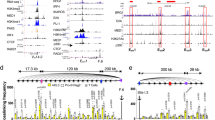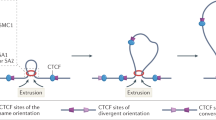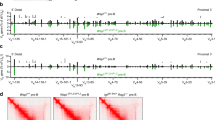Abstract
V(D)J recombination assembles genes encoding antigen receptors according to defined developmental programs in immature B and T lymphocytes. The 'accessibility hypothesis' was initially invoked to explain how a single recombinase complex could control the locus and allele specificity of V(D)J recombination. It has been since shown that recombination signal sequences themselves influence recombination efficiency and specificity in ways that had not been previously appreciated. Recent developments have increased our understanding of how the chromatin barrier to V(D)J recombination is regulated, and how chromatin control and the properties of the underlying recombination signal sequences may cooperate to create diverse, lineage-restricted and allelically excluded repertoires of antigen receptors.
This is a preview of subscription content, access via your institution
Access options
Subscribe to this journal
Receive 12 print issues and online access
$209.00 per year
only $17.42 per issue
Buy this article
- Purchase on Springer Link
- Instant access to full article PDF
Prices may be subject to local taxes which are calculated during checkout




Similar content being viewed by others
References
Fugmann, S.D., Lee, A.I., Shockett, P.E., Villey, I.J. & Schatz, D.G. The RAG proteins and V(D)J recombination: complexes, ends and transposition. Annu. Rev. Immunol. 18, 495–527 (2000).
Bassing, C.H., Swat, W. & Alt, F.W. The mechanism and regulation of chromosomal V(D)J recombination. Cell 109, S45–S55 (2002).
Hesslein, D.G.T. & Schatz, D.G. Factors and forces controlling V(D)J recombination. Adv. Immunol. 78, 169–232 (2001).
Yancopoulos, G. & Alt, F. Developmentally controlled and tissue-specific expression of unrearranged VH gene segments. Cell 40, 271–281 (1985).
Stanhope-Baker, P., Hudson, K.M., Shaffer, A.L., Constantinescu, A. & Schlissel, M.S. Cell type-specific chromatin structure determines the targeting of V(D)J recombinase activity in vitro. Cell 85, 887–897 (1996).
Kwon, J., Imbalzano, A.N., Matthews, A. & Oettinger, M.A. Accessibility of nucleosomal DNA to V(D)J cleavage is modulated by RSS positioning and HMG1. Mol. Cell 2, 829–839 (1998).
Golding, A., Chandler, S., Ballestar, E., Wolffe, A.P. & Schlissel, M.S. Nucleosome structure completely inhibits in vitro cleavage by the V(D)J recombinase. EMBO J. 18, 3712–3723 (1999).
Bories, J.-C., Demengeot, J., Davidson, L. & Alt, F.W. Gene-targeted deletion and replacement of the T-cell receptor β-chain enhancer: The role of enhancer elements in controlling V(D)J recombination accessibility. Proc. Natl. Acad. Sci. USA 93, 7871–7876 (1996).
Bouvier, G. et al. Deletion of the mouse T-cell receptor β gene enhancer blocks αβ T-cell development. Proc. Natl. Acad. Sci. USA 93, 7877–7881 (1996).
Sleckman, B.P., Bardon, C.G., Ferrini, R., Davidson, L. & Alt, F.W. Function of the TCRα enhancer in αβ and γδ T cells. Immunity 7, 505–515 (1997).
Inlay, M., Alt, F.W., Baltimore, D. & Xu, Y. Essential roles of the κ light chain intronic enhancer and 3′ enhancer in κ rearrangement and demethylation. Nat. Immunol. 3, 463–468 (2002).
Capone, M. et al. TCRβ and TCRα gene enhancers confer tissue- and stage-specificity on V(D)J recombination events. EMBO J. 12, 4335–4346 (1993).
Lauzurica, P. & Krangel, M.S. Temporal and lineage-specific control of T cell receptor α/δ gene rearrangement by T cell receptor α and δ enhancers. J. Exp. Med. 179, 1913–1921 (1994).
Hernandez-Munain, C., Sleckman, B.P. & Krangel, M.S. A developmental switch from TCRδ enhancer to TCRα enhancer function during thymocyte maturation. Immunity 10, 723–733 (1999).
Villey, I., Caillol, D., Selz, F., Ferrier, P. & de Villartay, J.-P. Defect in rearrangement of the most 5′ TCR-Jα following targeted deletion of T early α (TEA): implications for TCR α locus accessibility. Immunity 5, 331–342 (1996).
Sikes, M.L., Suarez, C.C. & Oltz, E.M. Regulation of V(D)J recombination by transcriptional promoters. Mol. Cell. Biol. 19, 2773–2781 (1999).
Whitehurst, C.E., Chattopadhyay, S. & Chen, J. Control of V(D)J recombinational accessibility of the Dβ1 gene segment at the TCRβ locus by a germline promoter. Immunity 10, 313–322 (1999).
McMurry, M.T., Hernandez-Munain, C., Lauzurica, P. & Krangel, M.S. Enhancer control of local accessibility to V(D)J recombinase. Mol. Cell. Biol. 17, 4553–4561 (1997).
Hempel, W.M. et al. Enhancer control of V(D)J recombination at the TCRβ locus: differential effects on DNA cleavage and joining. Genes Dev. 12, 2305–2317 (1998).
Whitehurst, C.E., Schlissel, M.S. & Chen, J. Deletion of germline promoter PDβ1 from the TCRβ locus causes hypermethylation that impairs Dβ1 recombination by multiple mechanisms. Immunity 13, 703–714 (2000).
Fernex, C., Capone, M. & Ferrier, P. The V(D)J recombinational and transcriptional activities of the immunoglobulin heavy-chain intronic enhancer can be mediated through distinct protein-binding sites in a transgenic substrate. Mol. Cell. Biol. 15, 3217–3226 (1995).
Tripathi, R.K. et al. Definition of a T-cell receptor β gene core enhancer of V(D)J recombination by transgenic mapping. Mol. Cell. Biol. 20, 42–53 (2000).
Angelin-Duclos, C. & Calame, K. Evidence that immunoglobulin VH-DJ recombination does not require germ line transcription of the recombining variable gene segment. Mol. Cell. Biol. 18, 6253–6264 (1999).
Sikes, M.L., Meade, A., Tripathi, R., Krangel, M.S. & Oltz, E.M. Regulation of V(D)J recombination: A dominant role for promoter positioning in gene segment accessibility. Proc. Natl. Acad. Sci. USA 99, 12309–12314 (2002).
McMurry, M.T. & Krangel, M.S. A role for histone acetylation in the developmental regulation of V(D)J recombination. Science 287, 495–498 (2000).
Mathieu, N., Hempel, W.M., Spicuglia, S., Verthuy, C. & Ferrier, P. Chromatin remodeling by the T cell receptor (TCR)-β gene enhancer during early T cell development: implications for the control of TCR-β locus recombination. J. Exp. Med. 192, 625–636 (2000).
Agata, Y. et al. Histone acetylation determines the developmentally regulated accessibility for T cell receptor-γ gene recombination. J. Exp. Med. 193, 873–879 (2001).
Huang, J., Durum, S.K. & Muegge, K. Cutting edge: histone acetylation and recombination at the TCR γ locus follows IL-7 induction. J. Immunol. 167, 6073–6077 (2001).
McBlane, F. & Boyes, J. Stimulation of V(D)J recombination by histone acetylation. Curr. Biol. 10, 483–486 (2000).
Cherry, S.R. & Baltimore, D. Chromatin remodeling directly activates V(D)J recombination. Proc. Natl. Acad. Sci. USA 96, 10788–10793 (1999).
Kwon, J., Morshead, K.B., Guyon, J.R., Kingston, R.E. & Oettinger, M.A. Histone acetylation and hSWI/SNF remodeling act in concert to stimulate V(D)J cleavage of nucleosomal DNA. Mol. Cell 6, 1037–1048 (2000).
Tse, C., Sera, T., Wolffe, A.P. & Hansen, J.C. Disruption of higher-order folding by core histone acetylation dramatically enhances transcription of nucleosomal arrays by RNA polymerase III. Mol. Cell. Biol. 18, 4629–4638 (1998).
Narlikar, G.J., Fan, H.Y. & Kingston, R.E. Cooperation between complexes that regulate chromatin structure and transcription. Cell 108, 475–487 (2002).
Strahl, B.D. & Allis, D. The language of covalent histone modifications. Nature 403, 41–45 (2000).
Jenuwein, T. & Allis, C.D. Translating the histone code. Science 293, 1074–1080 (2001).
Spicuglia, S. et al. Promoter activation by enhancer-dependent and -independent loading of activator and coactivator complexes. Mol. Cell 10, 1479–1487 (2002).
Su, I.H. et al. Ezh2 controls B cell development through histone H3 methylation and Igh rearrangement. Nat. Immunol. 4, 124–131 (2003).
Ng, H.H., Ciccone, D.N., Morshead, K.B., Oettinger, M.A. & Struhl, K. Lysine-79 of histone H3 is hypomethylated at silenced loci in yeast and mammalian cells: a potential mechanism for position-effect variegation. Proc. Natl. Acad. Sci. USA 100, 1820–1825 (2003).
Hsieh, C.-L. & Lieber, M.R. CpG methylated minichromosomes become inaccessible for V(D)J recombination after undergoing replication. EMBO J. 11, 315–325 (1992).
Mostoslavsky, R. et al. κ chain monoallelic demethylation and the establishment of allelic exclusion. Genes Dev. 12, 1801–1811 (1998).
Cherry, S.R., Beard, C., Jaenisch, R. & Baltimore, D. V(D)J recombination is not activated by demethylation of the κ locus. Proc. Natl. Acad. Sci. USA 97, 8467–8472 (2000).
Villey, I., Quartier, P., Selz, F. & de Villartay, J.-P. Germ-line transcription and methylation status of the TCR-Jα locus in its accessible configuration. Eur. J. Immunol. 27, 1619–1625 (1997).
Senoo, M. & Shinkai, Y. Regulation of Vβ germline transcription in RAG-deficient mice by the CD3ε-mediated signals: implications of Vβ transcriptional regulation in TCR β allelic exclusion. Int. Immunol. 10, 553–560 (1998).
Yannoutsos, N. et al. The role of recombination activating gene (RAG) reinduction in thymocyte development in vivo. J. Exp. Med. 194, 471–480 (2001).
Guo, J. et al. Regulation of the TCRα repertoire by the survival window of CD4+CD8+ thymocytes. Nat. Immunol. 3, 469–476 (2002).
Mauvieux, L., Villey, I. & de Villartay, J.-P. T early α (TEA) regulates initial TCRVAJA rearrangements and leads to TCRJA coincidence. Eur. J. Immunol. 31, 2080–2086 (2001).
Agalioti, T. et al. Ordered recruitment of chromatin modifying and general transcription factors to the IFN-β promoter. Cell 103, 667–678 (2000).
Kuo, M.-H., vom Baur, E., Struhl, K. & Allis, C.D. Gcn4 activator targets Gcn5 histone acetyltransferase to specific promoters independently of transcription. Mol. Cell 6, 1309–1320 (2000).
Vignali, M., Steger, D.J., Neely, K.E. & Workman, J.L. Distribution of acetylated histones resulting from Gal4-VP16 recruitment of SAGA and NuA4 complexes. EMBO J. 19, 2629–2640 (2000).
Travers, A. Chromatin modification by DNA tracking. Proc. Natl. Acad. Sci. USA 96, 13634–13637 (1999).
Orphanides, G. & Reinberg, D. RNA polymerase II elongation through chromatin. Nature 407, 471–475 (2000).
Feeney, A.J., Tang, A. & Ogwaro, K.M. B-cell repertoire formation: role of the recombination signal sequence in non-random V segment utilization. Immunol. Rev. 175, 59–69 (2000).
Cowell, L.G., Davila, M., Yang, K., Kepler, T.B. & Kelsoe, G. Prospective estimation of recombination signal efficiency and identification of functional cryptic signals in the genome by statistical modeling. J. Exp. Med. 197, 207–220 (2003).
Livak, F., Burtrum, D.B., Rowen, L., Schatz, D.G. & Petrie, H.T. Genetic modulation of T cell receptor gene segment usage during somatic recombination. J. Exp. Med. 192, 1191–1196 (2000).
Yu, K., Taghva, A. & Lieber, M.R. The cleavage efficiency of the human immunoglobulin heavy chain VH elements by the RAG complex: implications for the immune repertoire. J. Biol. Chem. 277, 5040–5046 (2002).
Bassing, C.H. et al. Recombination signal sequences restrict chromosomal V(D)J recombination beyond the 12/23 rule. Nature 405, 583–586 (2000).
Sleckman, B.P. et al. Mechanisms that direct ordered assembly of T cell receptor β locus V, D, and J gene segments. Proc. Natl. Acad. Sci. USA 97, 7975–7980 (2000).
Jung, D., Bassing, C.H., Cheng, H.-L., Schatz, D.G. & Alt, F.W. Extrachromosomal recombination substrates recapitulate beyond 12/23 restricted V(D)J recombination in nonlymphoid cells. Immunity 18, 65–74 (2003).
Tillman, R.E. et al. Cutting Edge: Targeting of Vβ to Dβ rearrangement by RSSs can be mediated by the V(D)J recombinase in the absence of additional lymphoid-specific factors. J. Immunol. 170, 5–9 (2003).
Liang, H.E. et al. The “dispensable” portion of RAG2 is necessary for efficient V-to-DJ rearrangement during B and T cell development. Immunity 17, 639–651 (2002).
Wu, C. et al. Dramatically increased rearrangement and peripheral representation of Vβ14 driven by the 3′ Dβ1 recombination signal sequence. Immunity 18, 75–85 (2003).
Gauss, G.H. & Lieber, M.R. The basis for the mechanistic bias for deletional over inversional V(D)J recombination. Genes Dev. 6, 1553–1561 (1992).
VanDyk, L.F., Wise, T.W., Moore, B.B. & Meek, K. Immunoglobulin DH recombination signal sequence targeting: effect of DH coding and flanking regions and recombination partner. J. Immunol. 157, 4005–4015 (1996).
Pan, P.Y., Lieber, M.R. & Teale, J.M. The role of recombination signal sequences in the preferential joining by deletion in DH-JH recombination and in the ordered rearrangement of the IgH locus. Int. Immunol. 9, 515–522 (1997).
Jones, J.M. & Gellert, M. Ordered assembly of the V(D)J synaptic complex ensures accurate recombination. EMBO J. 21, 4162–4171 (2002).
Mundy, C.L., Patenge, N., Matthews, A.G. & Oettinger, M.A. Assembly of the RAG1/RAG2 synaptic complex. Mol. Cell. Biol. 22, 69–77 (2002).
Chowdhury, D. & Sen, R. Stepwise activation of the immunoglobulin μ heavy chain gene locus. EMBO J. 20, 6394–6403 (2001).
Forsberg, E.C. & Bresnick, E.H. Histone acetylation beyond promoters: long-range acetylation patterns in the chromatin world. BioEssays 23, 820–830 (2001).
Bulger, M., Sawado, T., Schubeler, D. & Groudine, M. ChIPs of the β-globin locus: unraveling gene regulation within an active domain. Curr. Opin. Genet. Dev. 12, 170–177 (2002).
Schubeler, D. et al. Nuclear localization and histone acetylation: a pathway for chromatin opening and transcriptional activation of the human β-globin locus. Genes Dev. 14, 940–950 (2000).
Gribnau, J., Diderich, K., Pruzina, S., Calzolari, R. & Fraser, P. Intergenic transcription and developmental remodeling of chromatin subdomains in the human β-globin locus. Mol. Cell 5, 377–386 (2000).
Smale, S.T. Core promoters: active contributors to combinatorial gene regulation. Genes Dev. 15, 2503–2508 (2001).
West, A.G., Gaszner, M. & Felsenfeld, G. Insulators: many functions, many mechanisms. Genes Dev. 16, 271–288 (2002).
Zhong, X.-P. & Krangel, M.S. An enhancer-blocking element between α and δ gene segments within the human T cell receptor α/δ locus. Proc. Natl. Acad. Sci. USA 94, 5219–5224 (1997).
Sleckman, B.P., Carabana, J., Zhong, X.-P. & Krangel, M.S. Assessing a role for enhancer-blocking activity in gene regulation within the murine T-cell receptor α/δ locus. Immunology 102 (2001).
Melchers, F., ten Boekel, E., Yamagami, T., Andersson, J. & Rolink, A. The roles of preB and B cell receptors in the stepwise allelic exclusion of mouse IgH and L chain gene loci. Semin. Immunol. 11, 307–317 (1999).
Khor, B. & Sleckman, B.P. Allelic exclusion at the TCRβ locus. Curr. Opin. Immunol. 14, 230–234 (2002).
Chang, Y., Bosma, M.J. & Bosma, G.C. Extended duration of DH-JH rearrangement in immunoglobulin heavy chain transgenic mice: implications for regulation of allelic exclusion. J. Exp. Med. 189, 1295–1305 (1999).
Tripathi, R., Jackson, A. & Krangel, M.S. A change in the structure of Vβ chromatin associated with TCRβ allelic exclusion. J. Immunol. 168, 2316–2324 (2002).
Chowdhury, D. & Sen, R. Transient IL-7/IL-7R signaling provides a mechanism for feedback inhibition of immunoglobulin heavy chain gene rearrangements. Immunity 18, 229–241 (2003).
Johnson, K., Angelin-Duclos, C., Park, S. & Calame, K.L. Changes in histone acetylation are associated with differences in accessibility of VH gene segments to V-DJ recombination during B-cell ontogeny and development. Mol. Cell. Biol. 23, 2438–2450 (2003).
Lauster, R. et al. Promoter, enhancer and silencer elements regulate rearrangement of an immunoglobulin transgene. EMBO J. 12, 4615–4623 (1993).
Baker, J.E., Cado, D. & Raulet, D.H. Developmentally programmed rearrangement of T cell receptor Vγ genes is controlled by sequences immediately upstream of the Vγ genes. Immunity 9, 159–168 (1998).
Ye, S.K. et al. The IL-7 receptor controls the accessibility of the TCRγ locus by Stat5 and histone acetylation. Immunity 15, 813–823 (2001).
Hesslein, D.G. et al. Pax5 is required for recombination of transcribed, acetylated, 5′ IgH V gene segments. Genes Dev. 17, 37–42 (2003).
Mostoslavsky, R. et al. Asynchronous replication and allelic exclusion in the immune system. Nature 414, 221–225 (2001).
Singh, N. et al. Coordination of the random asynchronous replication of autosomal loci. Nature Genet. 33, 339–341 (2003).
Goldmit, M., Schlissel, M., Cedar, H. & Bergman, Y. Differential accessibility at the κ chain locus plays a role in allelic exclusion. EMBO J. 19, 5255–5261 (2002).
Singh, N., Bergman, Y., Cedar, H. & Chess, A. Biallelic germline transcription at the κ immunoglobulin locus. J. Exp. Med. 197, 743–750 (2003).
Gilbert, D.M. Replication timing and transcriptional control: beyond cause and effect. Curr. Opin. Cell Biol. 14, 377–383 (2002).
Goren, A. & Cedar, H. Replicating by the clock. Nat. Rev. Mol. Cell Biol. 4, 25–32 (2003).
Zhang, J., Xu, F., Hashimshony, T., Keshet, I. & Cedar, H. Establishment of transcriptional competence in early and late S phase. Nature 420, 198–202 (2002).
Zhou, J., Ermakova, O.V., Riblet, R., Birshtein, B.K. & Schildkraut, C.L. Replication and subnuclear location dynamics of the immunoglobulin heavy-chain locus in B-lineage cells. Mol. Cell. Biol. 22, 4876–4889 (2002).
Kosak, S.T. et al. Subnuclear compartmentalization of immunoglobulin loci during lymphocyte development. Science 296, 158–162 (2002).
Acknowledgements
I thank B. Sleckman, E. Oltz, G. Kelsoe, Y. Bergman, M. Schlissel and C. Schildkraut for helpful insights and critically reviewing the manuscript. Work in my laboratory is supported by grants from the National Institutes of Health (GM 41052 and AI 49934).
Author information
Authors and Affiliations
Rights and permissions
About this article
Cite this article
Krangel, M. Gene segment selection in V(D)J recombination: accessibility and beyond. Nat Immunol 4, 624–630 (2003). https://doi.org/10.1038/ni0703-624
Issue Date:
DOI: https://doi.org/10.1038/ni0703-624
This article is cited by
-
Regulatory mechanisms of B cell responses and the implication in B cell-related diseases
Journal of Biomedical Science (2019)
-
T cell pathology in skin inflammation
Seminars in Immunopathology (2019)
-
Current status and recent advances of next generation sequencing techniques in immunological repertoire
Genes & Immunity (2016)
-
Visualization and quantification of monoallelic TCRα gene rearrangement in αβ T cells
Immunology & Cell Biology (2014)
-
Equal opportunity for all
The EMBO Journal (2012)



